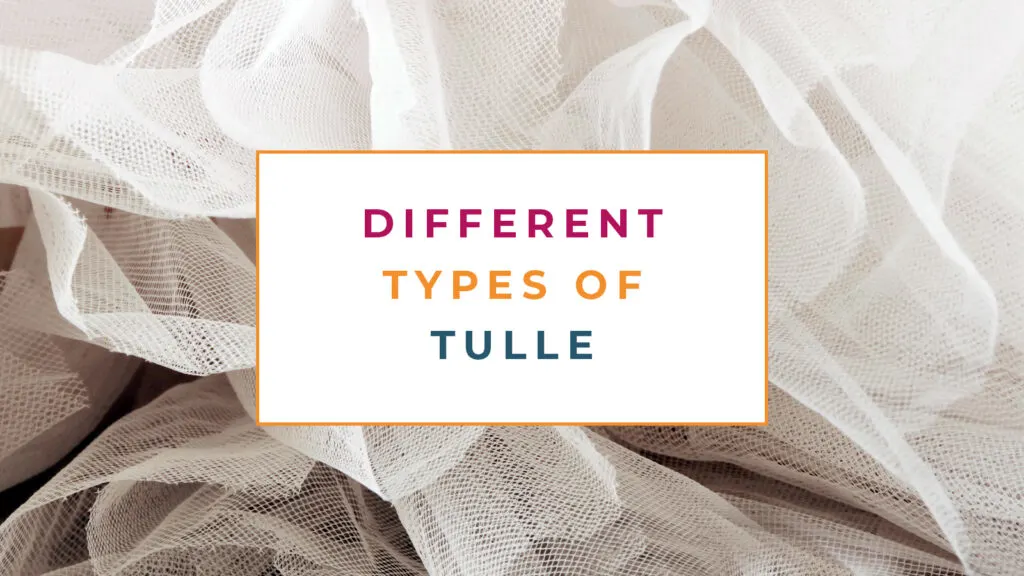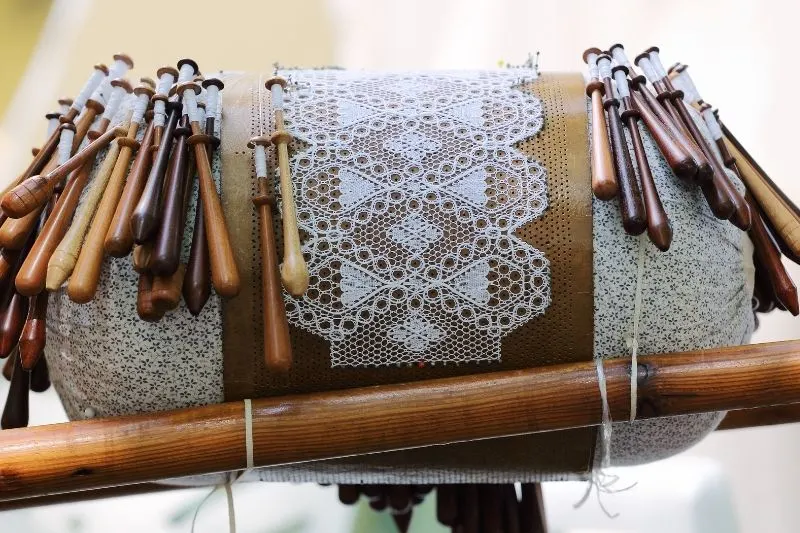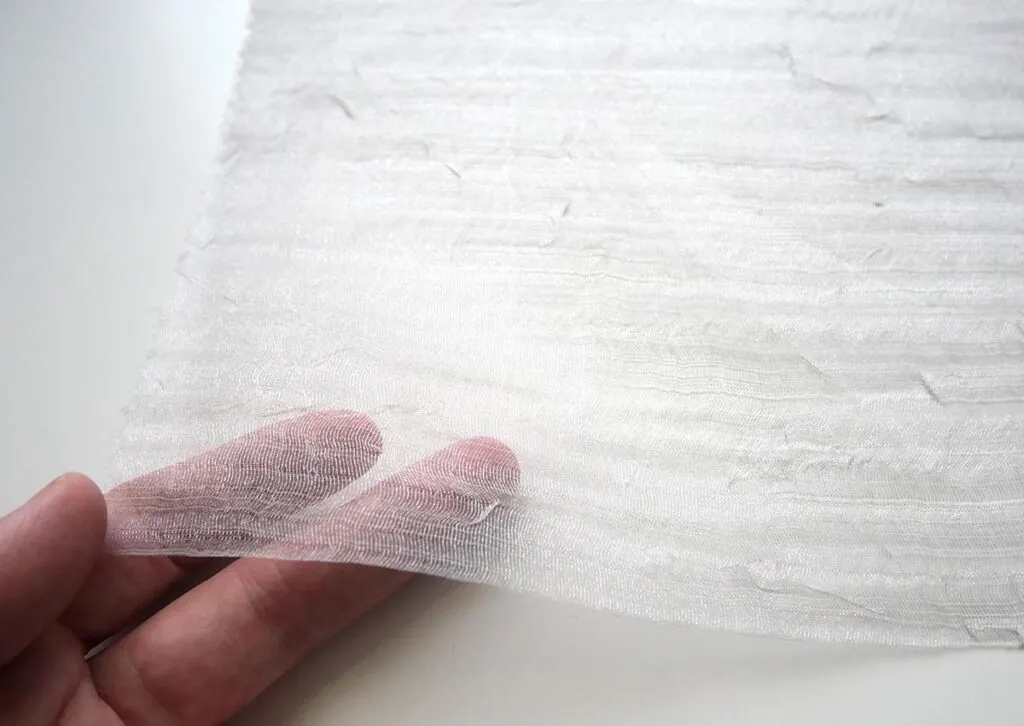In this guide, you’ll learn about the different types of tulle and the best ways to sew it, so that your next project turns out beautiful too!
What Is Tulle?

Tulle fabric is a sheer fabric type, and looks like a net fabric. It can be quite stiff or more soft and drapey, depending on the size of the yarn it is created from, and which of the following fibres it is uses:
- Cotton
- Nylon
- Polyester
- Rayon
- Silk
What Is Tulle Fabric Used For?
Tulle fabric (pronounced like tool) is usually more expensive than standard net fabric – which is usually made from nylon – and so is often used for bridal wear, formal gowns and in luxury or couture fashion.
In fact, one of it’s main uses for a bridal gown is as a wedding veil!
It can be used as the main support fabric for the skirt of a bridal gown – it is often paired with different types of lace fabric – or used to add decorative trim on dresses and lingerie.
Why Is It Called Tulle?
Tulle was first created in 1817, in the small town of Tulle in France, which is part of how the fabric received its name. It became popular in 1849, when it was used to create dresses for Queen Victoria of England, due to its lightness. It’s also known as bobbinet, as it was originally created similar to bobbin lace, and created a net fabric – bobbinet!
Where Is Tulle Fabric Made?
Tulle is now made all over the world, but many of the high-quality tulle fabrics are still manufactured in France.
How Is Tulle Made?

Tulle can be produced in different ways depending on its intended use. The main difference between types of tulle is the size of the mesh.
Back in the early 1800s, the first real machine for making traditional tulle was created by John Heathcoat, who studied the way lace was manually made by hand, and then created a machine to replicate the process.
In 1824 the bobbinet machine was able to create a simple plain tulle, and the machine has evolved very little over the years since!

Tulle is popular due to its two key qualities – it is very lightweight, which makes it great for creating dresses, skirts and even suits.
It can also be used to create many layers without adding significant weight or making the garment look bulky.
Is Tulle Natural Or Synthetic?
Tulle made from polyester and nylon is synthetic, and when made from cotton or silk, it is natural.
You’ll notice when comparing them, that the synthetic versions are a little stiffer than the natural versions.
What Is Tulle Netting?
Tulle netting is tulle fabric that has been woven into a thin mesh-like pattern, usually on a nylon base. This makes it ideal for creating decorations and appliques rather than garments.
What Is The Difference Between Organza And Tulle?

Tulle fabrics are usually made from nylon, cotton or silk whereas organza fabrics are made from silk, polyester or a blend of the two. This means that tulle fabrics are softer, while organza fabrics hang in more stiff way.
Is Tulle And Netting The Same Thing?
In a word, yes, as tulle is a type of netting. However, you’ll have seen some cheaper nets in craft stores and fabric shops and these are not the same quality as what I am referring to when I talk about tulle.
What Is The Difference Between Crinoline And Tulle?
Crinoline is a stiff fabric which has many layers and is ideal for making petticoats and hoop skirts. It is very different from tulle in its make-up and use, despite the fact that they are both used to create full skirts with lots of volume.
What Is The Best Tulle?

The best tulle is the one that is best for your sewing project! If you need a super soft tulle, then 100% silk tulle is the one to go for, but you do have options.
Cotton Tulle
Cotton tulle is made from 100% cotton and is a little cheaper than pure silk which makes it ideal if you’re just looking for something similar in quality.
However, cotton tulle does lack the durability of 100% silk tulle and so isn’t ideal for applications such as wedding gowns where the tulle fabric will be lifted and put under stress.
100% cotton tulle is also not the best choice when making tutus as the threads are more likely to become loose or come apart – the result of which is that your tutu may fall to pieces!
English Silk Tulle
English tulle – also referred to as English netting – is 100% silk tulle and has a larger weave. It is one of the more sheer options available and its durability is somewhere between cotton tulle and 100% silk tulle.
If you need it to be stiffer, you can of course starch it for a little added stiffness.
French Silk Tulle
100% French silk tulle is exactly as described – pure 100% silk with a fine weave for a smooth, soft fabric that is durable. It makes stunning dresses, but be prepared to pay a lot as this is one of the more expensive tulle fabrics around.
Illusion Tulle
Illusion tulle, also referred to as illusion net or French illusion netting is a type of English net that has been given a smaller weave. This results in a thinner fabric which has a completely transparent effect when put under light.
Illustion tulle is not made from silk. It is often created from nylon or a polyester and nylon blend. Due to its lightweight and sheer properties, illusion tulle is often a more economical option.
Italian Tulle
A very soft tulle, Italian tulle is made in Italy on special machines. It can be made from nylon or silk, and comes in a variety of colors.
Nylon Tulle
Nylon tulle is very similar in appearance to cotton tulle but it has some important differences.
Due to the fact that nylon is so much less absorbent than either silk or cotton, nylon tulle will hold its shape better and will stand up to washing better than cotton or silk tulle.
Polyester Tulle
This is the tulle often called ‘net fabric’ and is mostly used in crafting rather than dressmaking although this less expensive option can also be used in applications where the tulle will come under some stress, as it is stronger than both cotton and silk tulle.
Silk Tulle
This tulle is made from 100% silk which makes it the most delicate of all tulle fabrics. However, it’s also one of the most beautiful and luxurious fabrics to sew with!
Other Tulle Types
Tulle can also be created using a blend – lurex is a popular addition which makes the tulle or net slightly sparkly.
Tulle can also be modified by printing on it, embellishing it and even bonding it with latex / PVC to create an incredibly structured yet sheer material.
How Do I Care For My Tulle?

As tulle is a delicate fabric, it should be treated as such to prevent it from ripping or any other damage. It shouldn’t be machine washed as the risk of damage is very high, and a dryer should also be avoided too as the heat will damage the fabric.
This is also true for dry cleaning or ironing tulle fabric!
The best way to care for your tulle, is to hand wash in cold water, avoid agitation, and then lay flat to dry – hanging could stretch out and distort the fabric due to the way it is constructed.
If your tulle needs an iron, place it in a steamy bathroom instead – the steam will help!
How Do I Sew Tulle?

Because of the way tulle is made, it doesn’t fray! But, sewing tulle is a little different to sewing other fabric types and these tips will help:
1. As tulle is very sensitive to heat avoid both ironing and steaming it.
2. Cutting tulle can be tricky as the finer varieties are very soft and slippy. A rotary cutter and self healing cutting mat can help
3. If you have one, a walking foot is great for sewing tulle with a sewing machine. You may also find that a teflon presser foot is helpful too. Otherwise a regular sewing machine will work, but follow the next tip!
If sewing tulle by hand, make sure to use a larger needle with a thicker thread, so that there is some strength to hold the layers of tulle together!
4. Take your time and sew slowly! When sewing tulle, it’s worth taking your time to avoid any snagging of the fabric. Also be mindful not to stretch the fabric as you sew!
5. Make sure you choose the right needle. You can either sew with a zigzag stitch or a longer straight stitch setting on your machine.
6. To hem your tulle, you can use a variety of methods:
a. A simple raw hem – as the fabric is knitted, it won’t fray and so the hem can be left raw.
b. If you want to have a finished hem, you can stitch ribbon or horsehair to the hem to give it a neater finish.
7. To reinforce the seams of your tulle garment, use a strip of tulle over the top to reinforce it. As the fabric is sheer, a reinforcing layer will not make much different to how transparent or opaque the fabric is.
Where To Buy Tulle

You’ll find tulle fabrics in craft and fabric shops but you will get better quality tulle fabrics if you go to a specialist supplier. These are available online and it’s always a good idea to ask for or purchase small samples – this will give you a better idea of the different types of tulle and once you’ve handled them, you’ll better understand how they can be used for different projects.
If possible, before purchasing your tulle check out where it was made – France tends to be the best place to get finer, natural tulle and more mass produced synthetic tulles come from Asia. You’ll get an idea from the price – the higher the price the more likely it is that the tulle you’ve fallen in love with is made in England or France!
